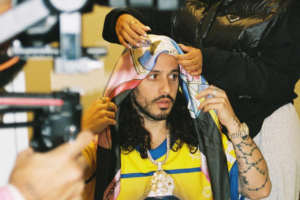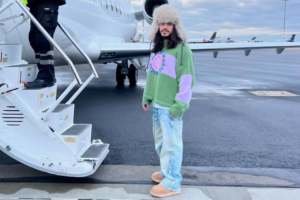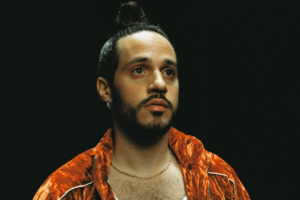In a candid conversation that peels back the layers of success in the music industry, rapper and entrepreneur Russ reveals the complex relationship between achievement and self-worth. As an artist who has reached the pinnacle of commercial success—platinum records, sold-out shows, and Forbes list appearances—Russ confronts the sobering reality that external validation often masks deeper internal struggles. His journey from omnipotence to vulnerability offers a compelling narrative about mental health in hip-hop and the evolving definition of masculine strength.
In the gleaming penthouses of success, where platinum plaques line the walls and bank accounts swell with seven-figure sums, an uncomfortable truth often emerges: external achievement, no matter how impressive, cannot fill an internal void. This paradox lies at the heart of Russ’s journey, offering a profound lesson about the nature of success and fulfillment that resonates far beyond the music industry.
“When you get everything you thought you wanted and you still feel empty,”
Russ reflects, “you realize that wow, that was not what I was supposed to be chasing.” This revelation comes not from a place of failure, but from the summit of achievement – platinum records, sold-out shows, and Forbes list appearances. It’s a sentiment that echoes through corner offices and creative studios alike, where high achievers often find themselves wondering why their impressive resumes fail to silence their inner critics.

The journey to this understanding often follows a predictable pattern. First comes the belief that the next milestone will finally bring contentment: “Maybe double platinum will do it, maybe triple… oh you made ten million? Maybe eleven million will make you feel good.” It’s a seductive logic that propels many to extraordinary heights of success while simultaneously preventing them from enjoying the view once they arrive.
This pursuit becomes particularly poignant in the context of seeking validation. For Russ, like many others, success became a substitute for approval – specifically, the approval of his father, transformed into an endless quest for industry recognition.
“I replaced my dad with the industry,”
he admits, highlighting how childhood patterns of seeking validation often shape our adult pursuits in ways we don’t initially recognize.
What makes this paradox particularly cruel is that success does bring real benefits and privileges. As Russ acknowledges, life is indeed better with financial security and the ability to pursue one’s passion. The trap lies not in achieving success, but in expecting it to heal wounds that require different medicine altogether. It’s akin to treating a broken arm with a bandage – the treatment, while valuable in its own right, simply doesn’t address the underlying issue.
The path through this paradox begins with a crucial distinction: the difference between accomplishment and fulfillment. Accomplishment lives in the external world of metrics and milestones; fulfillment resides in the internal realm of self-worth and purpose. Understanding this distinction doesn’t diminish the value of success, but rather puts it in its proper place – as a byproduct of pursuing meaningful work rather than a cure for deeper insecurities.
The real breakthrough comes when individuals begin to “grow down” instead of just growing up – diving deeper into self-understanding rather than simply climbing higher on the ladder of success. This internal journey, while less visible than external achievements, often proves to be the key to transforming success from a hollow victory into a genuine source of joy.
In the quiet moments between achievements, when the accolades have been hung and the applause has faded, perfectionism reveals its true nature – not as a path to excellence, but as a fortress built from childhood wounds. For Russ, like many high achievers, this revelation came through the lens of therapy, where the pursuit of perfection could finally be seen for what it was: a child’s strategy for earning love that had outlived its usefulness.
“My dad’s standard was Perfection,” Russ reflects, describing a childhood where a 92 on a test wasn’t celebrated but scrutinized for the missing eight points. This exacting standard, initially external, eventually became internalized – the critical parent’s voice transforming into an inner critic that would prove harder to satisfy than any record label or audience.
The evolution of perfectionism from protection to prison happens so gradually that many don’t notice the walls closing in until they’re fully confined. What begins as a child’s adaptive response to demanding circumstances – “If I’m perfect, then I’ll be loved” – morphs into an adult’s reflexive rejection of help, vulnerability, and even growth. As Russ discovered, “Being a perfectionist, there’s no room for me to not be right, there’s no room for me to not know what’s going on.”
This perfectionism manifests in peculiar ways in professional life. For some, it appears as omnipotence – the need to know everything, to be right about everything, to never show weakness or uncertainty. Others might recognize it in the endless revisions of a project, the inability to celebrate achievements, or the constant moving of goalposts.
“If you’re a perfectionist,” Russ notes, “there’s no room for criticism, and help is coded as criticism.”
The breakthrough often comes through therapy, where the protective patterns of perfectionism can be understood with compassion rather than judgment. This understanding reveals a crucial truth: perfectionism isn’t actually about being perfect – it’s about avoiding the perceived catastrophe of being imperfect. For many, like Russ, this fear traces back to childhood experiences where love or approval seemed conditional on performance.
Learning to give grace to past versions of oneself becomes a crucial part of breaking free from perfectionism’s chains. As Russ explains, “I can’t be mad at 23-year-old me that he didn’t know what 30-year-old me knows.” This perspective shift – from harsh judgment to understanding – creates space for genuine growth rather than the endless pursuit of an impossible standard.
The path forward isn’t about abandoning excellence but about redefining it. It’s about understanding that real growth often comes from embracing imperfection rather than avoiding it, from allowing ourselves to be learners rather than experts, from accepting help rather than rejecting it as criticism. In this way, breaking the chains of perfectionism isn’t about lowering standards – it’s about raising our capacity for self-compassion while maintaining our commitment to growth.
In the testosterone-fueled arena of hip-hop, where strength has traditionally been measured in bravado and battle scars, a quiet revolution is taking place. Artists like Russ are challenging the genre’s long-held assumptions about masculinity, proving that true strength might lie not in emotional armor, but in the courage to remove it.

“Society measures a Man based off of how much they can carry, how far they can carry it, and how alone they can carry it,” Russ observes, articulating a paradigm that has shaped not just hip-hop, but male identity across cultures. This stoic ideal has created generations of what he calls “professional hiders of pain” – men who have mastered the art of suppression while being celebrated for their silence.
The contradiction becomes particularly stark in hip-hop, where artists are expected to transform pain into art while maintaining an impenetrable facade. As Russ notes with piercing insight, “Some women looking at you lesser if there’s tears on your cheek, but if there’s tears tattooed that same girl is a freak.” The industry, and society at large, often wants the aesthetic of vulnerability without its messy reality – the tattoo of the tear, but not the tear itself.
Breaking this pattern requires a particular kind of courage that paradoxically challenges traditional notions of masculine strength. “How strong of a man are you,” Russ asks, “if you’re scared to face yourself?” This reframing transforms vulnerability from a weakness to be avoided into a challenge to be met, appealing to the very masculine desire for courage that often prevents men from seeking help.
The balance between vulnerability and artistic authenticity presents its own challenges. In a genre where credibility is currency, showing weakness might seem like professional suicide. Yet Russ has found that authentic vulnerability, when expressed with artistic integrity, resonates deeply with audiences. His music demonstrates that emotional honesty doesn’t diminish artistic power – it amplifies it.
This evolution in hip-hop mirrors broader societal changes in understanding masculine strength. The old model of the stoic, self-sufficient man is giving way to a more nuanced vision of masculinity that includes emotional intelligence and self-awareness. As Russ explains, “The pendulum has to swing at some point… this whole idea that men have to just be like military men who show nothing, no emotions… it’s just not sustainable.”
Creating space for emotional honesty in music becomes not just an artistic choice but a form of cultural leadership. When artists of Russ’s stature speak openly about therapy and emotional growth, they create permission for others to do the same. This ripple effect extends beyond music, challenging long-held assumptions about masculinity in communities where such conversations have traditionally been taboo.
The revolution in hip-hop masculinity isn’t about abandoning strength – it’s about redefining it. It’s about recognizing that facing one’s demons requires more courage than pretending they don’t exist, that seeking help demonstrates more strength than suffering in silence, and that true authenticity includes the full spectrum of human emotion, not just those deemed acceptably “masculine.”
In the glittering landscape of success, where platinum plaques line the walls and sold-out shows become routine, therapy often seems like an admission of defeat rather than a path to victory. For Russ, like many high achievers, the decision to seek help came not from a place of weakness, but from the exhaustion of maintaining an increasingly unsustainable facade of strength.
The breaking point arrived with characteristic drama – a European tour cancelled at the peak of success, when the carefully constructed walls of omnipotence finally crumbled. “My body and spirit and mind just shut down,” Russ recalls, describing a moment familiar to many who’ve pushed themselves beyond their limits while insisting they were fine. It’s often in these moments of crisis that the truth becomes unavoidable: strength isn’t about never falling; it’s about learning to rise again.
The journey through therapy revealed patterns that had been invisible in plain sight. Songs that seemed like mere artistic expression – “Nobody Knows” or “All to You” – revealed themselves as desperate cries for help, transformed into commodities by the very industry that celebrated them. “These were like such cries for help,” Russ reflects, “that I think made me feel more insane because I would put them out and they just became songs.”
Family dynamics emerged as a crucial piece of the puzzle. Russ’s role as the emotional savior of his family – the child running from room to room during arguments, ensuring everyone was okay – had shaped his adult identity in ways that required professional help to unravel. “My identity was tied to saving my family and helping them,” he explains, illuminating how childhood patterns can become adult prison cells without our awareness.
The facade of omnipotence, once a shield against criticism and vulnerability, began to reveal itself as a symptom rather than a solution. In therapy, Russ discovered that his need to be right about everything, to reject help, and to maintain perfect control were not signs of strength but manifestations of deep-seated insecurity. This revelation opened the door to a more authentic way of being, where strength could coexist with vulnerability.
Perhaps most profound was therapy’s impact on creative expression. The artist who once needed to be drunk to perform interviews found himself capable of facing audiences – and himself – with clear-eyed courage. The music began to change too, moving from masked pain to conscious exploration, from hiding behind bravado to leading with authenticity.
This transformation didn’t diminish his artistic power – it enhanced it. By breaking down the walls between personal growth and creative expression, therapy enabled a more genuine connection with audiences. The same vulnerability that once seemed like a threat to his image became its strongest asset, proving that authenticity, not perfection, is the true currency of lasting artistic impact.
The journey through therapy continues to unfold, revealing new layers of understanding and growth. For Russ, like many others who’ve taken this path, the process isn’t about fixing what’s broken but about discovering what was whole all along, beneath the layers of protective armor we build around ourselves.
In a culture obsessed with upward mobility – bigger houses, higher positions, larger followings – the concept of “growing down” emerges as a radical alternative. As Russ articulates, this counterintuitive journey isn’t about diminishment but about diving deeper into the core of who we are, beyond the carefully curated facades of success.

The distinction between growing up and growing down becomes clearest in moments of achievement. Growing up focuses on external metrics: more followers, more money, more accolades. Growing down, by contrast, involves exploring the root system of our being – understanding not just what we’ve accomplished, but who we are beneath those accomplishments. “I wasn’t focused on growing down into the core of who I am,” Russ reflects, describing years spent climbing the ladder of success while avoiding the deeper journey of self-discovery.
Perhaps the most challenging aspect of growing down is learning to sit with insecurity rather than masking it. In professional settings, this might mean acknowledging uncertainty instead of projecting false confidence. For Russ, it meant confronting the vulnerability of performing sober instead of using alcohol as emotional armor. This practice requires a particular kind of courage – not the bravado of pretending to be unshakeable, but the authentic strength of acknowledging our human complexity.
The process of growing down often reveals uncomfortable truths. For some, like Russ, it might be the recognition that “I don’t like myself” – a devastating revelation that paradoxically becomes the foundation for genuine self-acceptance. This journey challenges the common assumption that self-discovery always leads to self-celebration, acknowledging instead that real growth often begins with honest acknowledgment of our struggles.
Authentic self-expression emerges naturally from this deeper understanding. When we’re no longer trying to maintain a perfect image, we can create from a place of truth rather than performance. In music, this might mean writing lyrics that expose real vulnerability rather than maintaining a carefully constructed persona. In business, it might mean leading with genuine humanity rather than projected authority.
The reward for this courageous descent comes in the form of genuine connections. When we stop performing perfection and start sharing our authentic experiences – including our doubts, fears, and struggles – we create space for others to do the same. “Is everyone nervous?” Russ suggests asking at social gatherings, describing how acknowledging shared vulnerability can instantly transform the energy of a room.
Growing down requires a fundamental shift in how we measure progress. Instead of asking “How far up have I climbed?” we might ask “How deeply have I understood?” Instead of “What have I achieved?” we might consider “What have I learned about myself?” This reorientation doesn’t negate the value of external success but places it in proper perspective – as one aspect of a fuller, richer life rather than its sole defining measure.
The path of growing down isn’t easy – it requires facing parts of ourselves we’ve spent years avoiding, accepting imperfections we’ve tried to hide, and embracing vulnerabilities we’ve attempted to overcome. Yet in this descent, we often find what we’ve been searching for all along: not the perfect version of ourselves we thought we needed to become, but the authentic self we already are, waiting to be discovered beneath the layers of performance and pretense.
In the summer of 2021, as Russ reopened Paulo Coelho’s “The Alchemist,” he discovered what readers throughout the decades have found: that sometimes a book finds you at exactly the moment you need it most. The timing wasn’t coincidental but serendipitous – just as he began crafting his album, Coelho himself appeared in Russ’s Twitter feed, one of only 160 accounts the legendary author followed, a sign that seemed to echo the book’s central theme about the universe conspiring to help those who pursue their Personal Legend.
The relationship between literature and music has always been intimate, but what Russ discovered in revisiting “The Alchemist” transcended mere inspiration. The book, which he had first encountered at age 17 through his friend Boogie, revealed new layers of meaning when read through the lens of his adult experiences. Like many great works, it spoke differently to him at different stages of life, offering fresh insights that seemed perfectly calibrated to his current struggles.
Initially, Russ intended to create a direct parallel to Santiago’s journey, but the project evolved into something more nuanced. As he explains, it was Coelho’s own words about Santiago’s journey being everyone’s journey that provided the permission he needed to tell his own story. This revelation transformed the album from an adaptation into a conversation – not just with the book, but with the universal themes it explores.
The parallels between Santiago’s journey and personal growth emerge naturally throughout the album. Just as Santiago must learn to read omens and trust in the universe’s guidance, Russ found himself navigating his own signs and synchronicities. The wind and the oasis, metaphors central to Coelho’s work, find new meaning in Russ’s music, transformed through the alchemy of personal experience into fresh insights about success, fulfillment, and the nature of true wealth.
What makes this intersection of literature and music particularly powerful is how it bridges introspection and entertainment. The album doesn’t simply retell The Alchemist’s story but uses it as a framework to explore contemporary themes of mental health, success, and personal transformation. This approach creates multiple layers of meaning – the songs can be enjoyed purely as music while offering deeper resonance for those familiar with their literary inspiration.

Coelho’s appreciation of the project adds another layer of meaning, creating a full circle moment that seems lifted from the pages of his own work. It’s a reminder that artistic influence isn’t just about borrowing themes or ideas, but about continuing a conversation across generations and mediums, each artist adding their own voice to an ongoing dialogue about the human experience.
The result is more than just an album inspired by a book – it’s a demonstration of how different art forms can illuminate each other, creating new pathways for understanding both the original work and our own journeys. Through this creative alchemy, Russ transforms personal struggle into universal truth, much as Coelho did before him, proving that the best art doesn’t just tell stories – it helps us understand our own.
In the evolving landscape of hip-hop, where success has traditionally been measured in streams, sales, and social media metrics, Russ’s journey offers a compelling reimagining of what it means to truly succeed. His transformation from a metrics-driven artist to a voice for emotional authenticity doesn’t just challenge hip-hop’s status quo – it provides a blueprint for anyone struggling to reconcile external achievement with internal fulfillment.
The journey began, as many do, with the attainment of traditional success markers. Platinum records lined the walls, sold-out shows became routine, and Forbes list appearances confirmed what seemed like the ultimate arrival. Yet in the quiet moments between achievements, a deeper truth emerged: the accolades that were supposed to fill the void of self-doubt had only made it more apparent.
What makes Russ’s evolution particularly significant is his willingness to document it in real-time, through both his music and his public dialogue about mental health. His song “I Love You Boy” stands as a testament to this new paradigm, offering not just vulnerability but a roadmap for others seeking to bridge the gap between success and fulfillment. As he notes, “You deserve a pat on the back” – a simple phrase that acknowledges both the achievement and the human being behind it.
The impact of this shift extends far beyond music. In a culture increasingly dominated by carefully curated images of success, Russ’s transparency about therapy, personal struggles, and the ongoing journey of self-discovery provides permission for others to embrace their own complexity. His message resonates particularly strongly with young men who, like him, have been taught that strength means silence and success means solitude.
Perhaps most importantly, Russ demonstrates that vulnerability and excellence aren’t mutually exclusive. His continued commercial success while openly discussing mental health and personal growth challenges the notion that authenticity compromises artistry. Instead, it suggests that true artistry might actually require the courage to be authentic.
This new blueprint for success isn’t about abandoning ambition or rejecting achievement. Rather, it’s about expanding our definition of what it means to succeed. It’s about recognizing that platinum plaques and personal growth aren’t opposing forces but complementary aspects of a life well-lived. In Russ’s words, “It was you all along” – a reminder that the external validation we chase often distracts from the internal wisdom we already possess.
As hip-hop continues to evolve, Russ’s journey offers a glimpse of its potential future: one where vulnerability is valued alongside virtuosity, where mental health is as important as material wealth, and where success is measured not just in what you achieve, but in who you become along the way.
In the vibrant tapestry of Nigerian music, the journey from church pew to global stage is a well-worn path, yet Oxlade’s story carries its own distinct resonance. Within the hallowed walls of a Pentecostal church in Mushin, Lagos, a three-year-old boy who had lost his mother found his voice before he found his words. Under the watchful eye of his grandmother, a church deaconess, young Oxlade’s musical foundation was being carefully laid, though neither could have predicted the heights it would eventually reach.
The now-iconic dance moves that accompanied the performance weren’t the result of careful choreography but rather spontaneous expression. In a moment that would be replicated countless times across social media platforms, Oxlade’s natural movements became a cultural phenomenon. The impact was immediate and far-reaching—fans began tattooing his signature “97” design, TikTok created a filter based on his performance, and people even used markers to recreate his look for Halloween costumes.
What makes this viral moment particularly fascinating is its organic nature. In an era where content is often engineered for virality, Oxlade’s Colors Studio performance stands as a testament to the power of authentic artistic expression. The performance’s success wasn’t measured just in views or shares, but in how it resonated across cultural boundaries, inspiring genuine connection and creative response from audiences worldwide.
This moment serves as a masterclass in artistic intuition. While the music industry often operates on careful calculation and strategic planning, Oxlade’s experience demonstrates that sometimes the most powerful connections with audiences come from trusting one’s artistic instincts, even—or especially—when they run counter to established plans. The spontaneous decision to change songs, combined with a performance that prioritized feeling over presentation, created something that no amount of careful planning could have engineered: a genuine moment of artistic truth that resonated across the global stage.
In the polished landscape of contemporary African music, where collaborations often feel manufactured and albums can seem like mere collections of potential singles, Oxlade’s approach to his latest project stands apart with refreshing authenticity. Set for release on September 20th, the album emerges as a carefully curated testament to artistic evolution, where each collaboration springs from genuine connection rather than strategic calculation.
Perhaps most striking is Oxlade’s philosophical approach to the album’s creation. When asked about his favorite track, he responds with an artist’s wisdom: “If I had a favorite song, why am I dropping the others?” This isn’t mere deflection but rather a reflection of his holistic view of artistic creation. He views himself not as a curator of hits but as a vessel through which the music flows, allowing listeners to forge their own connections with each track.
The album’s collaborative spirit reveals itself through unexpected pathways. Dave, the UK rap phenomenon, stands as the only artist with whom Oxlade shared physical studio space during the recording process. This face-to-face interaction during the pandemic era adds a layer of intimacy to their collaboration that transcends the typical digital exchange of verses. The rest of the features, including a stunning contribution from Popcaan, emerged through a more modern process of remote collaboration, yet each maintains the warmth of genuine artistic connection.
One particular collaboration speaks to the album’s emotional depth: a track featuring Oxlade’s father, One Day Call. This intergenerational musical dialogue transforms the album from mere collection of songs into a personal document of growth and reconciliation. It’s a powerful reminder that in an era of carefully calculated features and strategic guest appearances, sometimes the most impactful collaborations come from the heart.
The project’s creation during Oxlade’s two-year world tour adds another layer of complexity to its narrative. Despite the geographical challenges of recording while constantly in motion, each collaboration maintains its integrity through what Oxlade describes as authentic relationships that extend “beyond studio sessions.” These connections manifest in meaningful exchanges about music, life, and artistry, proving that genuine artistic collaboration can transcend physical proximity.
Take, for instance, the track with Popcaan, which initially was conceived with Chronix in mind. When Chronix proved unavailable, taking one of his characteristic “spiritual breaks,” the song found its way to Popcaan through organic industry connections. The result, as Oxlade notes, feels predestined – a perfect marriage of artist and song that could only have emerged through authentic artistic process rather than forced collaboration.

This approach to album creation offers a masterclass in artistic integrity. In an era where albums are often assembled through algorithmic predictions and market research, Oxlade’s project stands as a reminder that the most compelling musical narratives emerge from genuine artistic expression and real human connection. It’s not just a collection of songs, but a document of growth, relationship, and artistic evolution.
In the ever-evolving discourse surrounding African music’s global ascendance, few voices speak with the clarity and conviction of Oxlade on the matter of cultural identity. His perspective on Afrobeats transcends mere musical categorization, instead positioning it as a fundamental expression of African identity—a cultural force that extends far beyond melody and rhythm into the very fabric of daily life.
“Afrobeats is not just music,” Oxlade asserts with characteristic passion. “It’s our DNA, it’s who we are.” This declaration serves not as mere rhetoric but as a framework for understanding the genre’s true scope. In his view, Afrobeats encompasses everything from Twitter banter to dance moves, from pandemic-era cultural moments to the shared experience of eating jollof rice. It’s a holistic cultural expression that defies simple categorization.
Drawing a powerful parallel to hip-hop’s evolution, Oxlade points to how even Kendrick Lamar, with all his lyrical innovation and artistic boundary-pushing, still proudly operates under the banner of hip-hop. This comparison underscores a crucial point about cultural ownership and identity: innovation need not mean abandonment of roots. “We as Nigerians, we as Africans need to know the power of togetherness and the power of identity,” he emphasizes, pushing back against the tendency to splinter into subgenres and alternative classifications.
This stance comes at a crucial moment in African music’s global journey. As the genre gains international recognition, there’s an increasing pressure to modify, to adapt, to perhaps make the sound more palatable for global consumption. Yet Oxlade advocates for a different approach: one that maintains cultural authenticity while embracing natural evolution. “In the race of trying to be different from the rest,” he cautions, “you should know you come from somewhere.”
His perspective offers a masterclass in cultural pride and artistic integrity. While some artists might view their cultural identity as a limitation to transcend, Oxlade sees it as a foundation to build upon. This approach doesn’t restrict innovation but rather enriches it, providing a deep well of cultural experience from which to draw inspiration.
The implications of this viewpoint extend beyond music into questions of cultural preservation and evolution in a globalized world. When Oxlade speaks of Afrobeats as “a way of life,” he’s articulating a vision of cultural expression that refuses to be confined to artistic boundaries. It’s a reminder that the most powerful cultural movements aren’t just about artistic output—they’re about the complete lived experience of a people.
This perspective challenges both artists and audiences to think more deeply about the relationship between cultural identity and artistic expression. In an era where global fusion is often celebrated without question, Oxlade’s stance suggests that true innovation comes not from diluting one’s cultural identity, but from embracing it fully while allowing it to evolve naturally.
In the narrative of ar


